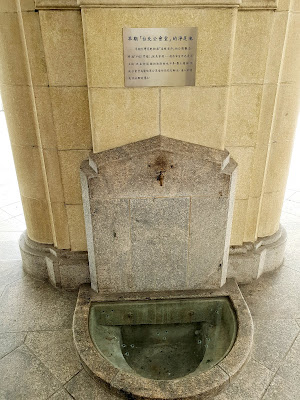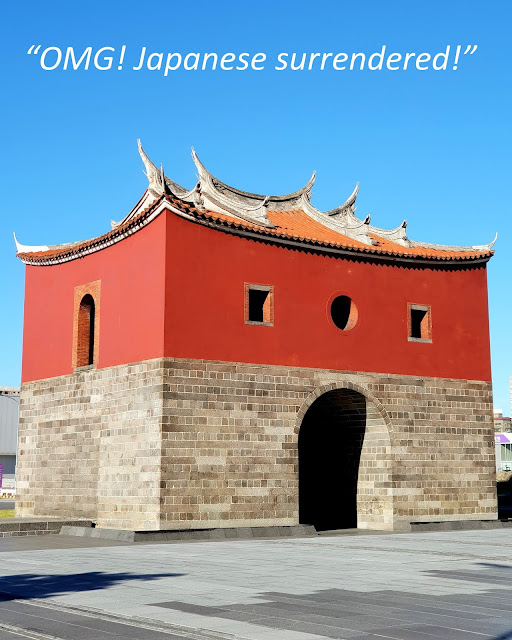(I) WALK THE HISTORY : Taipei North Gate & Zhongshan Hall
The foundation of a new prefectural capital, with enclosing wall in 1879
Craftsmen were recruited for the construction in 1882
The wall was completed in 1884
The city's walls and the (a)West Gate were destroyed as part of the cities restructuring plan in the Japanese colonial rule (ca. 1895)
After Taiwan's handover in 1945 the (b)East, (c)South, and (d)Auxiliary South Gates were rebuilt, but the original appearances were not maintained. The (e)North Gate alone retains its original appearance.
The East Gate is today's gateway to Ketagalan Boulevard.
The Auxiliary South Gate was built from generous donation of Zhangzhou migrants Banqiao Lin family to separate themselves from the West Gate rivals - Quanzhou migrants.
(http://www.lse.ac.uk/researchAndExpertise/units/TaiwanProgramme/Journal/JournalContents/TCP5Jacobs.pdf) Taiwan in Comparative Perspective, Vol. 5, July 2014, pp. 47–59 ISSN 1752-7732
© Taiwan Research Programme, London School of Economics Taiwan’s Colonial Experiences and the Development of Ethnic Identities: Some Hypotheses1 J. Bruce Jacobs Asian Languages and Studies, Monash University
a.
d.
e.
NORTH GATE Taipei 2018
Legend of a female food vendor who changed City's fate.
Legend of a female food vendor who changed City's fate.
Koo Hsien-jung was a Taiwanese businessman and politician who enjoyed strong links to the colonial administration of Taiwan under Japanese rule. He founded the Koos Group of companies, the largest business group in Taiwan. Koo was a businessman at the time of the Treaty of Shimonoseki in which Qing dynasty China ceded Taiwan to Japan.
When the Japanese forces arrived in Taiwan in 1895, Koo initiated contact with the Japanese forces in Keelung and urged them to enter Taipei to restore order.
An award certificate dated 1895 by Japanese Guardian Chief given to 陳法 wrote "Chen Fa, on June 7th 1895, when Japanese troops faced tall, thick stoned wall and roof, she risked her life and helped them in. For this bravery, she was rewarded 銀五圓 (5 silver dollars).
Other Taiwanese sources includes an account by her daughter-in-law in 1937, interviewed by a Japanese High-School teacher: "my mother-in-law and me first made ropes from blanket and cloth we found to help a few Japanese climb the wall, and then she and my husband found bamboo ladder - about a dozen or more of them got inside the wall, managed to find the key and opened the gate."
Qing 'North Gate Street' to 'Provincial Administration Hall'
ROC 'Yanping South Road' to 'Zhongshan Hall'
ROC 'Yanping South Road' to 'Zhongshan Hall'
left side of the building - row of camera shops
2. 清真黃牛肉麵館 Halal Beef Noodles(There are two. Side by side. I don't know of their connection. One (in the link) is original shop since 1950. Chang's is relocated from Bo-Ai Road)
3. Li-Du Japanese Restaurant (Since 1943)
I remember my grandparents' used to order bento from Lidu for their Saturday Mahjong. One of the very few Japanese bento delivery in the 1970s.
4. 東一排骨 Dong Yi Pork Chop Main Store (since 1971)
Features: A great place to enjoy a Taiwanese atmosphere and home-style Taiwanese food.
Good-value and tasty food.
Funky deco resembling 1970s disco ball room + night market souvenir shops. So flashy and so Taiwanese.
Proud of their senior waiting staff, some might have served since the opening.
Generous space and hospitality - apparently the owner owns the property.
5. 雪王冰淇淋 Snow King Ice Cream (Since 1947)
I had a Buddha Head Fruit flavour. It's ok. More for the novelty of unusual flavours for anyone's liking. As for the value - can't really say what. There are certainly better quality ice cream for that price. But if eating for the whole package - sweet, fun and originality. It's not unworthy of a visit.
It does feel the owners struggle to keep up with today's 'chic' style. There is that old-fashion Taiwanese sloppiness (and messiness) to it. Though I don't think they think or see what's 'wrong' with it.
6. 臺北中山堂 Taipei Zhongshan Hall
1887 The Qing Dynasty Taiwan Provincial Administration Hall.
1928 Dismantled to commemorate the ascension of Japanese Emperor Hirohito.
1936 The Taipei Assembly Hall/Taipei City Public Auditorium after ¥980,000 and the efforts of some 94,500 workers.
Check it out!: Foot basins
1945 Japan surrendered to the Allied Forces, ending World War II, and Taiwan was returned to Chinese rule. The formal ceremony of the surrender of Taiwan took place with great solemnity at the Taipei City Public Auditorium. General Chen Yi, Chief of the Taiwan Provincial Administrative Office, represented the Supreme Military Commander of the Republic of China in accepting the surrender of Ando Rikichi, the Japanese Governor-General of Taiwan and Commander of the 10th Japanese Area Army. The occasion marked Taiwan's return to Chinese governance after five decades of Japanese rule.
On the China side - Chiang KS appointed and sent He Yingqin as representative at the September 9th ceremony in Nanjing to accept the statement of surrender submitted by General Yasuji Okamura.
NOTE: 台北放送局Taipei Broadcasting Bureau (Today's 228 Peace Memorial Park) -
aired Emperor Hirohito's Surrender Speech. August 15, 1945
photos taken in July 2018
'Fortress Cafe 堡壘咖啡' (sit at the balcony on a nice day!) - Recommend!
There are many reasons I recommend 'Fortress Cafe' - for its historical significance, its classic deco, and good standard food. For those haven't been, it would be a surprisingly delightful experience. On a good day and at night - sit at the balcony!
(I decided to do a PART II on the Cafe alone - see the same title PART II)
Says the NORTH GATE 😲
~ END OF PART I ~





































Great article, Katy! I get what you mean about Snow King’s Old school style, but I did REALLY love their basil ice cream. The kaohliang and pork floss ones...not to much :)
ReplyDeleteThanks for reading!
ReplyDelete